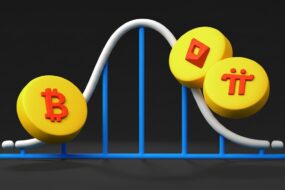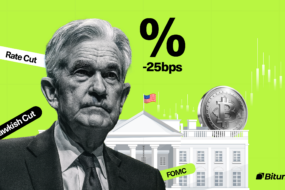
Bitcoin has just gone through one of its sharpest repricings of the year. On November 14, the Bitcoin price sliced through the psychological 100,000 USDT level and dropped to an intraday low near 96,600 USDT, its weakest print since May. At the same time, global risk sentiment deteriorated, with United States tech stocks under pressure and investors moving back toward safer assets.
The current move has the characteristics of a new Bitcoin bear market phase, driven by weaker ETF inflows, distribution by long term holders and a lack of fresh retail participation. Our analysts view this as a structural reset in both Bitcoin price and positioning, not just a chart driven correction.
What Drove Bitcoin Below 100,000
The first driver behind this Bitcoin crash is the macro environment. Expectations for rapid interest rate cuts have been scaled back, which has hurt risk assets in general. High valuation tech stocks and other growth names sold off, and Bitcoin was pulled into the same risk off wave. When large funds de risk, they often reduce Bitcoin exposure alongside equities and other high beta assets.
Flows that previously supported the Bitcoin price have also softened. Spot Bitcoin ETF inflows have slowed compared with earlier in the year. On chain data shows that long term holders are realizing profits and distributing part of their positions into the market. At the same time, on exchange spot volumes and new wallet activity suggest that retail investors are cautious and are not stepping in aggressively on the dip.
When institutional inflows weaken, long term holders sell into strength and retail traders remain passive, Bitcoin loses three important sources of demand at once. Under these conditions, a break of a major psychological level such as 100,000 can trigger a sharp move lower as liquidity thins out beneath it.
Key Bitcoin Price Levels And Liquidity Zones
From a structural point of view, the loss of the monthly midline around 100,266 USDT was an important signal. Once Bitcoin failed to hold that level, the market began to accelerate into areas of lower liquidity. The current Bitcoin price structure that we are monitoring can be summarized in a few key zones.
On the downside, the first significant Bitcoin support area sits in the 93,000 to 95,000 USDT range. This is where buyers have previously shown interest and where resting bids and derivatives hedging activity tend to concentrate. If the Bitcoin price can stabilize here, it increases the probability that this zone can act as a base for consolidation.
If that band fails, the next notable liquidity pocket lies near 89,600 USDT. Below that level, the order book becomes thinner again and daily volatility could rise further.
On the upside, the first serious rebound resistance is around 100,200 USDT, just above the broken psychological threshold. The next stronger resistance band sits close to 107,300 USDT. Until Bitcoin can reclaim and hold at least the 100,000 region with convincing volume, rallies are more likely to be treated as short term bounces inside a broader downtrend.
Why We View This Bitcoin Move As Structural Repricing
Not every decline in the Bitcoin price has the same meaning. In our assessment, this latest move is best described as structural repricing rather than a standard technical pullback. Several elements support this view.
First, leverage in the derivatives market has been flushed out quickly. Perpetual futures funding rates and open interest have compressed, which indicates that a large share of leveraged long positions has been closed. This is typical of a Bitcoin bear market phase where excessive optimism is cleared from the system.
Second, institutional participation has shifted. The large funds and corporate buyers that previously added Bitcoin on dips are now either on the sidelines or reducing exposure. This type of capital tends to adjust positions methodically over time, so its withdrawal signals more than a one day change in sentiment.
Third, the narratives that helped drive the last leg of the rally have cooled. Earlier, Bitcoin ETF momentum, halving expectations and broader digital asset adoption stories provided a strong backdrop. Today, those narratives remain in place but carry less urgency in a world where macro uncertainty has increased and investors are more selective.
Taken together, these factors indicate that the market is revaluing Bitcoin under a different set of conditions, and is searching for a new equilibrium price rather than simply unwinding an overbought technical pattern.
What Needs To Happen For A Bitcoin Base To Form
In our internal work we highlighted the 93,000 USDT region as a line in the sand for the current Bitcoin bear market phase. The behaviour of price and flows around this support band will tell us a lot about the next stage.
If the 93,000 to 95,000 USDT area holds and the Bitcoin price spends time consolidating above it, that would be an early signal that the market is attempting to build a base. In that scenario we would look for signs such as stabilizing ETF flows, a slowdown in selling from long term holders and a gradual return of spot buying interest.
If the Bitcoin price breaks cleanly below this support and trades into the 89,000 region or lower, the probability of a deeper bear phase increases. In that case, the market would be entering thinner liquidity zones and could require more time and more aggressive repricing before a durable bottom can form.
The precise intraday low is less important than the combination of price action and flow data. Sustainable Bitcoin bottoms tend to occur only after excess leverage has been cleared, weak hands have capitulated and patient capital has begun accumulating at lower levels.
How Bitcoin Traders And Investors Can Approach This Phase
A move of this magnitude at these absolute price levels can be challenging, especially for newer participants. However, a clear structure can help traders and investors manage risk more effectively.
Short term Bitcoin traders should recognize that volatility is elevated and order book depth may be reduced in key zones. Position sizing, use of leverage and stop placement need to reflect this reality. Overextension during a Bitcoin crash can quickly lead to forced liquidations.
Medium and long term investors should revisit their time horizon and thesis rather than react to every hourly move. For them, the focus should be on whether the long term Bitcoin story remains intact and whether current prices fairly compensate for the additional volatility.
In practice, it is useful to respect the key Bitcoin support and resistance zones. The 93,000 to 95,000 range on the downside and the 100,200 and 107,300 regions on the upside are reference points where liquidity and positioning often change character. Waiting for confirmation around these areas can help avoid emotional trades in the middle of the range.
It is also important to track flows alongside price. ETF flows, exchange reserves, derivatives positioning and on chain activity from long term holders provide context that raw candles cannot. A tentative base in the Bitcoin price is more convincing when it coincides with improving flows, not only a single sharp bounce.
Bitunix View On The Current Bitcoin Market
From our perspective at Bitunix, this latest Bitcoin price decline is a necessary reset after a powerful expansion phase. The previous rally pushed valuations higher, crowded long positioning and encouraged reliance on favourable narratives. The combination of macro stress, weaker ETF inflows and renewed distribution by long term holders has forced the market to reassess what an appropriate clearing level should be.
We are cautious in the near term, especially while liquidity is trending lower and key supports have not been firmly confirmed. At the same time, we recognize that Bitcoin bear markets often plant the seeds of the next cycle by transferring coins from weaker to stronger hands.
Our role is to monitor price structure, flow data and macro conditions, and to share a clear, objective view of what they imply. Each trader and investor should make independent decisions based on their own research, risk tolerance and time horizon. Bitcoin remains a high volatility asset, and protecting capital is just as important as seeking returns, particularly in the early stages of a new bear phase.
About Bitunix
Bitunix is a global cryptocurrency derivatives exchange trusted by over 3 million users across more than 100 countries. At Bitunix, we are committed to providing a transparent, compliant, and secure trading environment for every user. Our platform features a fast registration process and a user-friendly verification system supported by mandatory KYC to ensure safety and compliance. With global standards of protection through Proof of Reserves (POR) and the Bitunix Care Fund, we prioritize user trust and fund security. The K-Line Ultra chart system delivers a seamless trading experience for both beginners and advanced traders, while leverage of up to 125x and deep liquidity make Bitunix one of the most dynamic platforms in the market.
Bitunix Global Accounts
X | Telegram Announcements | Telegram Global | CoinMarketCap | Instagram | Facebook | LinkedIn | Reddit | Medium
Disclaimer: Trading digital assets involves risk and may result in the loss of capital. Always do your own research. Terms, conditions, and regional restrictions may apply.









